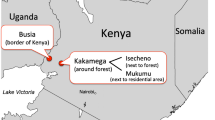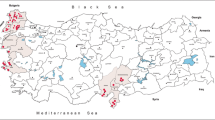Abstract
Viruses transmitted to vertebrates via arthropod vectors (so-called arboviruses) include many important pathogens such as dengue virus, Zika virus, and Sindbis virus. Mosquitoes represent the major vectors of many of these arboviruses and occur in all climatic zones, including the Arctic. The focal species, Aedes nigripes (Diptera: Culicidae), is the most widely distributed mosquito species in the Arctic. We screened over 11,000 specimens collected between 2012 and 2016 on Greenland (Kangerlussuaq) and Svalbard (Petuniabukta) for the presence of arboviruses which have previously been reported in latitudes up to 70°N. Assays for arbovirus detection using RT-PCR with primers specific for the genera Alphavirus (family Togaviridae), Orthobunyavirus, Phlebovirus (Bunyaviridae), Flavivirus (Flaviviridae), and Orbivirus (Reoviridae) were negative for all specimens. Similar results were recently obtained in a screening focused on tick-borne pathogens on Svalbard. The findings suggest that the circulation of arboviruses at studied localities is currently negligible or nonexistent, possibly due to dispersal, climate, or biotic restrictions. However, global climate change could enhance vector abundance and activity, introduction of invasive host species, and increase in tourism which then could lead to emerging arbovirus outbreaks in the future, with considerable impact on local ecosystems.

Similar content being viewed by others
References
Becker N, Petric D, Zgomba M, Boase C, Minoo M, Dahl C, Kaiser A (2010) Mosquitoes and their Control. Springer, Berlin Heidelberg
Bennike O, Higgins A, Kelly M (1989) Mammals of central North Greenland. Polar Rec 25:43–49. https://doi.org/10.1017/S0032247400009979
Carson PK, Holloway K, Dimitrova K, Rogers L, Chaulk AC, Lang AS, Whitney HG, Drebot MA, Chapman TW (2017) The seasonal timing of snowshoe hare virus transmission on the island of Newfoundland, Canada. J Med Entomol 54:712–718
Corbet PS, Downe AER (1966) Natural hosts of mosquitoes in northern Ellesmere Island. Arctic 19:153–161
Coulson SJ, Refseth D (2004) The terrestrial and freshwater invertebrate fauna of Svalbard (and Jan Mayen). In: Prestrud P, Strøm H, Goldman H (eds) A catalogue of the terrestrial and marine animals of Svalbard. Tromsø, Norway
Culler LE, Ayres MP, Virginia RA (2015) In a warmer Arctic, mosquitoes avoid increased mortality from predators by growing faster. Proc Royal Soc B 282:e20151549. https://doi.org/10.1098/rspb.2015.1549
Deardorff ER, Nofchissey RA, Cook JA, Hope AG, Tsvetkova A, Talbot SL, Ebel GD (2013) Powassan virus in mammals, Alaska and New Mexico, U.S.A., and Russia, 2004-2007. Emerg Infect Dis 19:2012–2016. https://doi.org/10.3201/eid1912.130319
Descamps S (2013) Winter temperature affects the prevalence of ticks in an Arctic seabird. PLoS ONE 8:e65374. https://doi.org/10.1371/journal.pone.0065374
Doherty RL, Carley JG, Murray MD, Main AJ, Kay BH, Domrow R (1975) Isolation of arboviruses (Kemerovo group, Sakhalin group) from Ixodes uriae collected at Macquarie Island, Southern Ocean. Am J Trop Med Hyg 24:521–526
Elsterova J, Cerny J, Mullerova J, Sima R, Coulson S, Lorentzen E, Strom H, Grubhoffer L (2015) Search for tick-borne pathogens in the Svalbard Archipelago and Jan Mayen. Polar Res. https://doi.org/10.3402/polar.v34.27466
Hubálek Z, Rudolf I, Nowotny N (2014) Arboviruses pathogenic for domestic and wild animals. Adv Virus Res 89:201–275. https://doi.org/10.1016/B978-0-12-800172-1.00005-7
Jenkins DW (1956) Ecology of Arctic and Subarctic mosquitos. Tenth International Congress of Entomology, Montreal, August 17-25, 1956: 627-634
Kuno G, Mitchell CJ, Chang GJ, Smith GC (1996) Detecting bunyaviruses of the Bunyamwera and California serogroups by a PCR technique. J Clin Microbiol 34:1184–1188
L’vov SD, Gromashevskiĭ VL, Skvortsova TM, Aristova VA, Golobinskiĭ EP, Gorin OZ, Kolobukhina LV, Bol’shakov EP, Morozova TN, Feoktistov AZ (1995) Mosquito-borne arboviruses in the Baikal region. Vopr Virusol 40:170–172 [In Russian]
La Linn M, Gardner J, Warrilow D, Darnell GA, McMahon CR, Field I, Hyatt AD, Slade RW, Suhrbier A (2001) Arbovirus of marine mammals: a new alphavirus isolated from the elephant seal louse, Lepidophthirus macrorhini. J Virol 75:4103–4109. https://doi.org/10.1128/JVI.75.9.4103-4109.2001
Major L, Linn ML, Slade RW, Schroder WA, Hyatt AD, Gardner J, Cowley J, Suhrbier A (2009) Ticks associated with Macquarie Island penguins carry arboviruses from four genera. PLoS ONE 4:e4375. https://doi.org/10.1371/journal.pone.0004375
Markova E, Sibiryakov P, Ehrich D (2016) Surviving in the high Arctic: dental variation in a casually introduced population of Microtus rossiaemeridionalis (Arvicolinae, Rodentia) on Svalbard. Acta Zool (Stockholm) 97:442–453
McLean DM (1975) Mosquito-borne arboviruses in Arctic America. Med Biol 53:264–270
McLean DM (1983) Yukon isolates of Snowshoe Hare virus, 1972–1982. Prog Clin Biol Res 123:247–256
McLean DM, Grass PN, Judd BD, Ligate LV, Peter KK (1977) Bunyavirus isolations from mosquitoes in the western Canadian Arctic. J Hyg (Lond) 79:61–71
McLean DM, Grass PN, Judd BD, Stolz KJ, Wong KK (1978) Transmission of Northway and St. Louis encephalitis viruses by Arctic mosquitoes. Arch Virol 57:315–322
McLean DM, Grass PN, Judd BD, Stolz KJ (1979) Bunyavirus development in arctic and Aedes aegypti mosquitoes as revealed by glucose oxidase staining and immunofluorescence. Arch Virol 62:313–322
Mitchell CJ, Lvov SD, Savage HM, Calisher CH, Smith GC, Lvov DK, Gubler DJ (1993) Vector and host relationships of California serogroup viruses in western Siberia. Am J Trop Med Hyg 49:53–62
Overland J, Hanna E, Hanssen-Bauer I, Kim SJ, Walsh JE, Wang M, Bhatt US, Thoman RL (2015) Surface air temperatures [in Arctic report card: update for 2015] (http://www.arctic.noaa.gov/reportcard)
Palacios G, Cowled C, Bussetti AV, Savji N, Weir R, Wick I, Travassos da Rosa A, Calisher CH, Tesh RB, Boyle D, Lipkin WI (2011) Rapid molecular strategy for Orbivirus detection and characterization. J Clin Microbiol 49:2314–2317. https://doi.org/10.1128/JCM.00337-11
Pedersen K, Marks DR, Wang E, Eastwood G, Weaver SC, Goldstein SM, Sinnett DR, DeLiberto TJ (2016) Widespread detection of antibodies to eastern equine encephalitis, West Nile, St. Louis encephalitis, and Turlock viruses in various species of wild birds from across the United States. Am J Trop Med Hyg 95:206–211. https://doi.org/10.4269/ajtmh.15-0840
Putkuri N, Kurkela S, Levanov L, Huhtamo E, Vaheri A, Sironen T, Vapalahti O (2014) Isolation and characterization of a California encephalitis serogroup orthobunyavirus from Finnish mosquitoes. Infect Genet Evol 22:164–173. https://doi.org/10.1016/j.meegid.2014.01.023
Putkuri N, Kantele A, Levanov L, Kivistö I, Brummer-Korvenkontio M, Vaheri A, Vapalahti O (2016) Acute human inkoo and chatanga virus infections, Finland. Emerg Infect Dis 22:810–817. https://doi.org/10.3201/eid2205.151015
Sahu SP, Pedersen DD, Ridpath HD, Ostlund EN, Schmitt BJ, Alstad DA (2002) Serologic survey of cattle in the northeastern and north central United States, Virginia, Alaska, and Hawaii for antibodies to Cache Valley and antigenically related viruses (Bunyamwera serogroup virus). Am J Trop Med Hyg 67:119–122
Sánchez-Seco MP, Rosario D, Quiroz E, Guzmán G, Tenorio A (2001) A generic nested-RT-PCR followed by sequencing for detection and identification of members of the alphavirus genus. J Virol Methods 95:153–161
Sánchez-Seco MP, Echevarría JM, Hernández L, Estévez D, Navarro-Marí JM, Tenorio A (2003) Detection and identification of Toscana and other phleboviruses by RT-nested-PCR assays with degenerated primers. J Med Virol 71:140–149. https://doi.org/10.1002/jmv.10465
Scaramozzino N, Crance JM, Jouan A, DeBriel DA, Stoll F, Garin D (2001) Comparison of flavivirus universal primer pairs and development of a rapid, highly sensitive heminested reverse transcription-PCR assay for detection of flaviviruses targeted to a conserved region of the NS5 gene sequences. J Clin Microbiol 39:1922–1927. https://doi.org/10.1128/JCM.39.5.1922-1927.2001
St George TD, Doherty RL, Carley JG, Filippich C, Brescia A, Casals J, Kemp DH, Brothers N (1985) The isolation of arboviruses including a new flavivirus and a new bunyavirus from Ixodes (Ceratixodes) uriae (Ixodoidea: Ixodidae) collected at Macquarie Island, Australia, 1975-1979. Am J Trop Med Hyg 34:406–412
Stansfield SK, Calisher CH, Hunt AR, Winkler WG (1988) Antibodies to arboviruses in an Alaskan population at occupational risk of infection. Can J Microbiol 34:1213–1216
Tingström O, Wesula Lwande O, Näslund J, Spyckerelle I, Engdahl C, Von Schoenberg P, Ahlm C, Evander M, Bucht G (2016) Detection of sindbis and inkoo virus rna in genetically typed mosquito larvae sampled in Northern Sweden. Vector Borne Zoonotic Dis 16:461–467. https://doi.org/10.1089/vbz.2016.1940
Traavik T, Mehl R, Wiger R (1978) California encephalitis group viruses isolated from mosquitoes collected in Southern and Arctic Norway. Acta Pathol Microbiol Scand B 86B:335–341
Vanlandingham DL, Davis BS, Lvov DK, Samokhvalov E, Lvov SD, Black WC, Higgs S, Beaty BJ (2002) Molecular characterization of California serogroup viruses isolated in Russia. Am J Trop Med Hyg 67:306–309
Walters LL, Tirrell SJ, Shope RE (1999) Seroepidemiology of California and Bunyamwera serogroup (Bunyaviridae) virus infections in native populations of Alaska. Am J Trop Med Hyg 60:806–821
Weaver SC, Reisen WK (2010) Present and future arboviral threats. Antiviral Res 85:328–345. https://doi.org/10.1016/j.antiviral.2009.10.008
Yoccoz NG, Ims RA (1999) Demography of small mammals in cold regions: the importance of environmental variability. Ecol Bull 47:137–144
Zarnke RL, Calisher CH, Kerschner J (1983) Serologic evidence of arbovirus infections in humans and wild animals in Alaska. J Wildl Dis 19:175–179
Acknowledgements
Our thanks belong to the whole team of the Centre of Polar Ecology at the Faculty of Science, University of South Bohemia, for their help and support during the field work, notably to Dr. Josef Elster for the possibility to participate in the field work on Svalbard, to Dr. Václav Pavel, Dr. Jan Kavan, Dr. Alexandra Bernardová, and Martin Lulák for logistic support, and to our laboratory technician Zuzana Vavrušková for her help with benchwork. Our thanks further belong to Dr. Daniel Růžek for the methodological and theoretical guidance of our team. The project was supported by LM2015078 CzechPolar2 - Czech Polar Research Infrastructure and ECOPOLARIS project No. CZ.02.1.01/0.0/0.0/16_013/0001708 provided by the Ministry of Education, Youth and Sports of the Czech Republic. Further, the research was supported by the Czech Grant Agency (GA15-03044S to JM, JC, and LG) and by ECDC & EFSA (funding to HK and DW within the VectorNet project). Funding was provided by Dartmouth’s Biology Department (R. Melville Cramer Fund) and a NSF IGERT Fellowship (NSF award 0801490) to LEC. Access to instruments and other facilities was supported by the Czech Research Infrastructure for Systems Biology C4SYS (project no LM2015055).
Author information
Authors and Affiliations
Corresponding author
Additional information
This article belongs to the special issue on the “Ecology of tundra arthropods,” coordinated by Toke T. Høye and Lauren E. Culler
Electronic supplementary material
Below is the link to the electronic supplementary material.
Rights and permissions
About this article
Cite this article
Müllerová, J., Elsterová, J., Černý, J. et al. No indication of arthropod-vectored viruses in mosquitoes (Diptera: Culicidae) collected on Greenland and Svalbard. Polar Biol 41, 1581–1586 (2018). https://doi.org/10.1007/s00300-017-2242-9
Received:
Revised:
Accepted:
Published:
Issue Date:
DOI: https://doi.org/10.1007/s00300-017-2242-9




